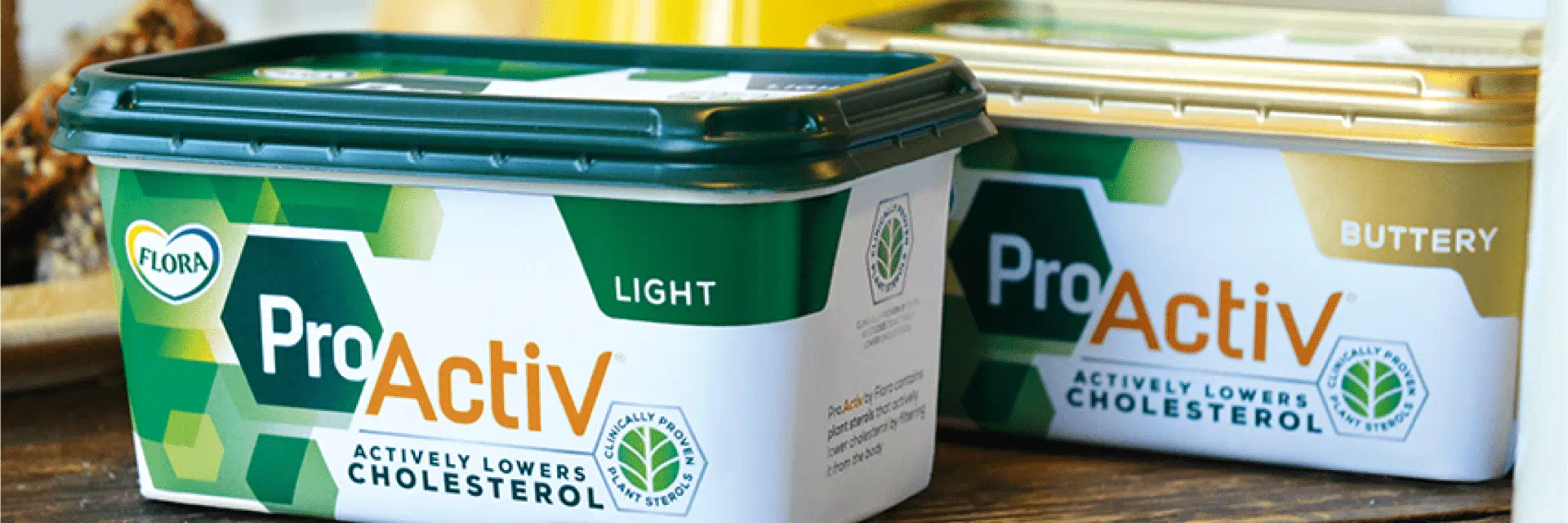Questions about Flora ProActiv
How does Flora ProActiv reduce cholesterol?
Flora ProActiv foods contain plant sterols that partially block your gut from absorbing cholesterol.* Read more about Flora ProActiv and cholesterol
Who can eat Flora ProActiv foods?
Flora ProActiv foods are suitable if you need to lower or actively manage your cholesterol levels.* You can eat them if you’re using cholesterol lowering medication, like statins.
You should always ask your GP for advice, including whether Flora ProActiv foods are suitable for you. They may not be nutritionally appropriate for pregnant and breastfeeding women or children under five.
How often should I eat Flora ProActiv foods?
For best results, Flora ProActiv foods should be eaten every day. Read more about portions.
How long does Flora ProActiv take to lower cholesterol?
Research shows that Flora ProActiv foods can reduce bad (LDL) cholesterol by 7 to 10% in as little as two to three weeks.
Questions about cholesterol
What is “high” cholesterol?
There are two main types of cholesterol. LDL, known as “bad” cholesterol, increases your risk of heart disease, and HDL, or “good” cholesterol, helps protect you. A raised level is normally a total count that’s higher than 5 mmol/L.
How can I increase my ‘good’ cholesterol levels?
Try getting more exercise and eating more unsaturated fats in place of saturated ones. It’s possible that moderate alcohol intake and eating more fruit and vegetables can help, too.
Read more about plant sterols.
Questions about food
Is shellfish bad for cholesterol levels?
Shellfish can contain a lot of dietary cholesterol, but it has only a small effect on blood cholesterol. As long as you enjoy shellfish as part of a healthy, balanced diet, they’re not a problem.
Would cutting out dairy help to lower my cholesterol?
Full-fat dairy products are often high in saturated fat, which raises your bad-cholesterol (LDL). However, low-fat dairy products, such as low-fat spreads and skimmed milk, don’t carry this risk and are an important part of a heart healthy diet. They also provide calcium, which is essential for healthy bones.
Would becoming a vegetarian help to lower my cholesterol?
You don’t need to become a vegetarian as long as you swap saturated for unsaturated fats and eat lean cuts of meat, lots of fruit and veg, wholegrain and low-fat dairy products.
How much oily fish should I eat and why?
Oily fish (like salmon, mackerel, sardines, pilchards and trout) contain omega 3 fatty acids, which help keep your heart healthy. According to the advice given by the NHS you should try to eat at least 1–2 portions of oily fish a week.**
Which foods are best for energy?
For starters, you must eat regularly, with a healthy balanced diet. Regular exercise will also help. Fruit and vegetables release energy slowly, providing it for longer. Other slow-release energy foods include whole grains, oats, pasta and noodles.
Are there any healthy alternatives to traditional snacks?
Yes, here are a few suggestions but you can also download our helpful food swap table:
- Fruit: fresh, frozen, tinned or dried
- Vegetables with a low-fat dip
- Olives, cherry tomatoes or unsalted nuts
- Diet yogurts
- Low-fat scones, buns, muffins or a slice of malt loaf
- Crackers and low-fat cottage cheese
What foods will fill me up so I don’t need to snack?
You need to eat foods that are slowly absorbed (also known as low GI foods). Choose porridge oats, beans, pulses, whole wheat pasta, bread, rice and any fruit or vegetables.
Questions about exercise
Is a brisk walk each day all it takes to keep your heart in shape?
Brisk walking is good for your heart but it’s important to keep your heart rate up, so you’ll need to increase your pace or climb a steeper hill as you get fitter.
Is aqua aerobics a good way to stay in shape?
Yes, aqua aerobics is safe and effective: a session can last from 45 minutes to an hour, giving you great cardiovascular benefits. And it’s proved very beneficial in improving flexibility and burning calories too!
Is it a good idea to jog outside in the winter?
It’s absolutely fine but preparation’s essential. Apply sun block, wear layers and use lightweight wicking fibres closest to your body. Wear socks made of synthetic fibres to help prevent blisters and athlete’s foot, keep your head covered and wear gloves. Warm up slowly and don’t do speed work in bone-chilling cold – wise runners stick to maintenance runs.

